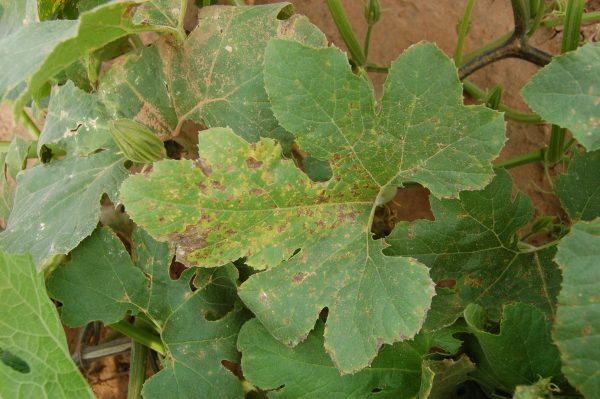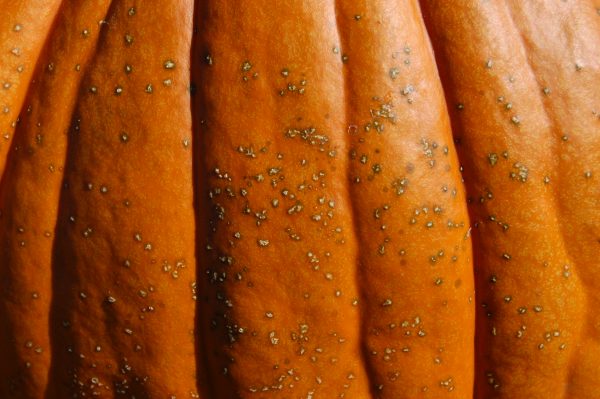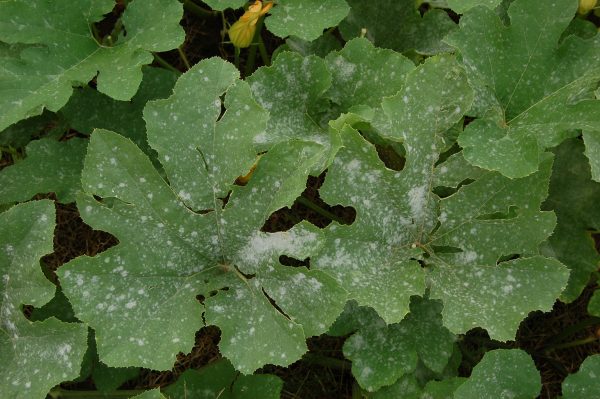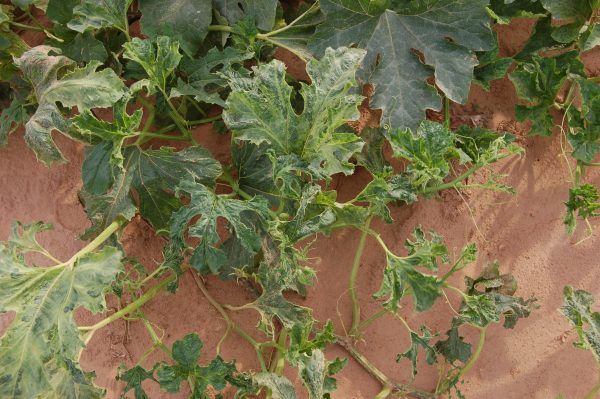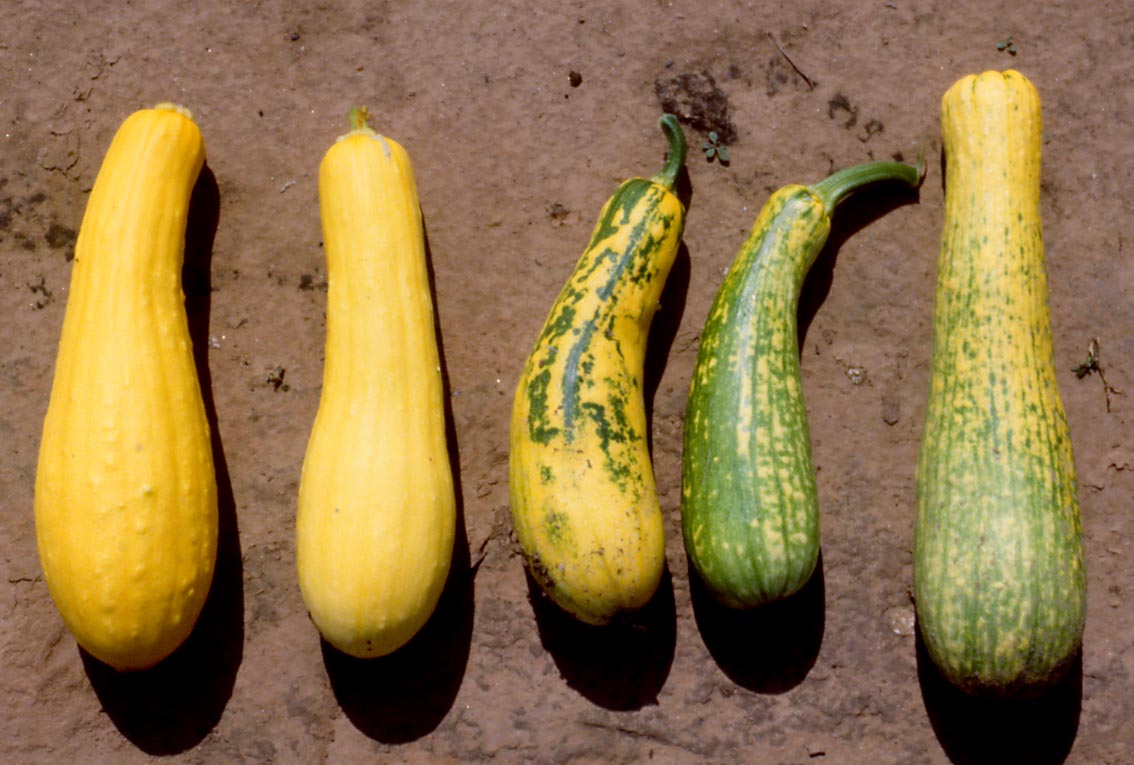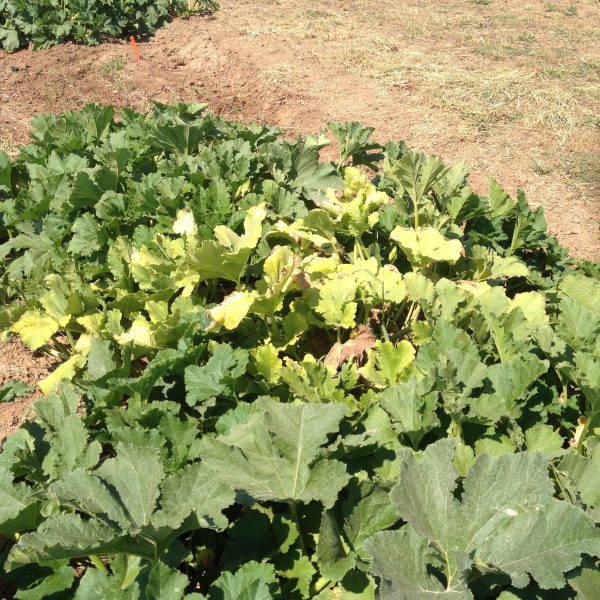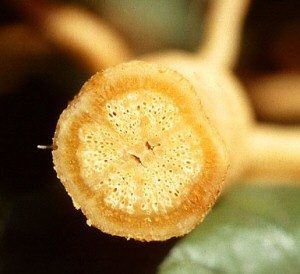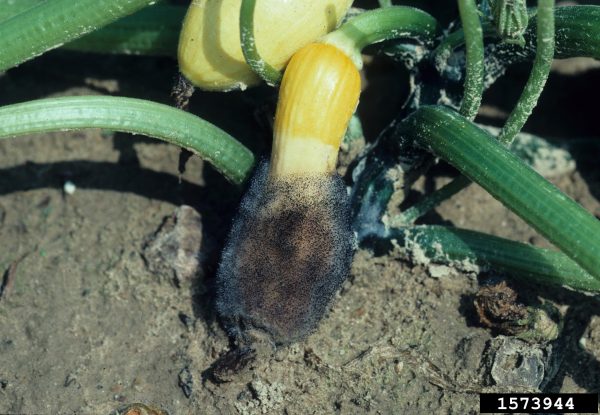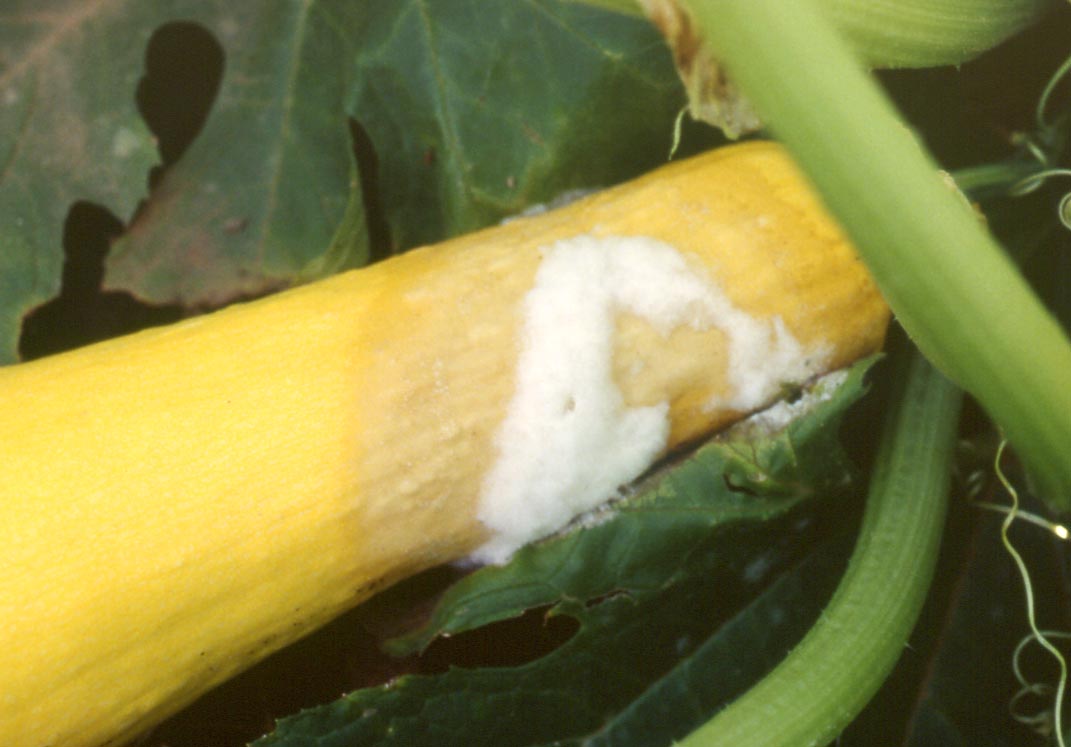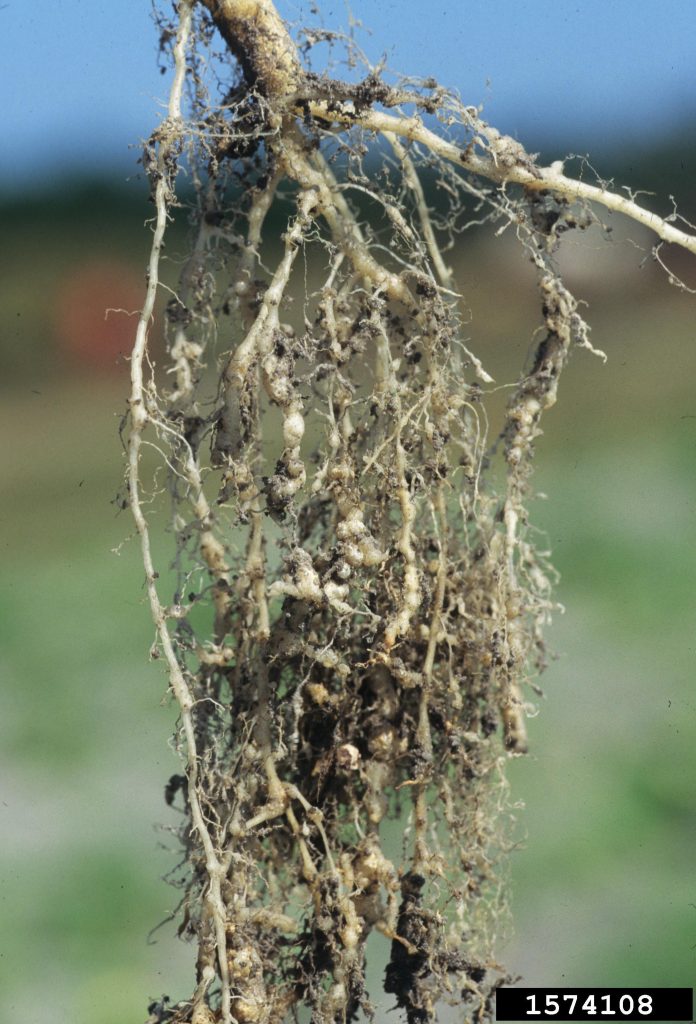Pumpkin and Squash Diseases
Squash and pumpkin are vegetable crops in the cucurbit family grown both on commercial farms and in residential gardens. Summer squash (straight-neck yellow and zucchini) are typically planted in the spring for harvest through early summer and planted in late summer for harvest in fall. Winter squash and pumpkins are typically grown for single harvests in the fall. Squash and pumpkins are generally well adapted to Oklahoma except that excessive summer heat in some years can delay pumpkin fruit set and maturity past optimum harvest for the Halloween jack-o’-lantern market.
As with all crops, pumpkins and squash are subject to abiotic and biotic diseases that can limit crop quality and yield. Abiotic diseases are caused by environmental conditions such as soil nutrient or pH imbalances, soil moisture extremes and chemical injuries (herbicides and other toxic chemicals). Biotic diseases are caused by plant pathogens that include fungi, bacteria, viruses and nematodes. Plant pathogens can directly attack the fruit, rendering it unmarketable. In addition, biotic diseases indirectly reduce yields by killing plants prior to harvest or by causing defoliation, which can reduce fruit size and quality as well as exposing fruit to sun scald.
The purpose of this publication is to aid in the identification of important biotic diseases of squash and pumpkin in Oklahoma and provide general guidelines for their management.
Disease Management Strategies
Integrated pest management (IPM) involves the use of several different strategies and the judicious use of pesticides for management of diseases and other cucurbit pests. Both conventional and organic growers should practice IPM. More effective and less costly control is usually achieved when IPM is practiced, compared to reliance on a single management practice, such as pesticide application. Management strategies that are components of an effective IPM system include:
Crop rotation: Fungi, bacteria and nematodes that cause soilborne and foliar diseases often survive
in the soil or on old crop debris and build up to damaging levels with
repeated cropping. To reduce pathogen survival and disease carryover a three- to four-year
rotation with non-cucurbit crops is recommended.
Site selection: Squash and pumpkin are best grown on sandy loam or silt loam soils with a pH of 6 to 7. Growth on acidic and/or poorly drained soils often results in increased incidence of root, crown and fruit rots. Late plantings should not be situated near earlier plantings where a disease already exists.
Sanitation: Old crop debris provides a site where many plant pathogens overwinter and survive between crops. Crop debris should be removed or incorporated into the soil to hasten its decomposition as soon as possible after harvest. Care should be taken to avoid contaminating planting areas with soil, diseased culls or diseased plant material.
Disease resistant varieties: Disease-resistant varieties of squash (virus diseases and powdery mildew) and pumpkin (powdery mildew) are available and should be planted where possible. Resistance is the most effective and economical means of disease control. For diseases such as mosaic virus, resistance is the only effective control.
Pathogen-free seed and transplants: Some diseases may be seedborne or introduced into fields on infected transplants. Efforts should be taken to obtain high-quality seed and transplants. Only transplants that appear healthy should be used.
Irrigation: Frequent applications of sprinkler irrigation with small amounts of water favor the spread and development of many diseases. Overhead irrigation produces splashing and runoff, which promotes movement of plant pathogens and increases the duration of leaf wetness – a condition that favors infection. Drip irrigation helps reduce diseases by not wetting foliage and by reducing pathogen spread from overhead sprinkler splashing or water runoff.
Chemical control: Spray programs with fungicide or bactericide (copper compounds) sprays may be needed
for effective management of foliar diseases. Consult the latest
edition of the E-832, OSU Extension Agent’s Handbook of Insect, Plant Disease and
Weed Control for a list of suggested treatments for specific diseases. Generally,
spray programs are most effective when applied on a regular (seven to 14 days) preventive
schedule. Organic growers have fewer spray options than conventional growers, but
many copper compounds and sulfur can be used in organic production.
Scouting: Plantings should be scouted regularly – at least once per week – for insect pests and diseases. Scouting allows for early pest detection so timely management practices can be implemented.
Disease identification: Correct disease identification is key to effective management. Incorrect identification
can lead to the implementation of an ineffective management
practice and crop failure. For example, diseases caused by bacteria or viruses are
not controlled with most fungicides. Furthermore, some fungicides will control one
fungal disease, but not another. Squash and pumpkin growers should learn to recognize
the more common diseases by their symptoms and have sufficient knowledge of disease
development to select appropriate management practices. Some diseases are easy to
identify in the field, while others are more difficult. The following descriptions
will aid in disease identification and if needed, the OSU Plant Disease and Insect
Diagnostic Laboratory offers disease diagnosis as a service to commercial growers
and residential gardeners. Samples can be submitted to the laboratory through local
county OSU Extension offices.
Bacterial leaf spot
(Xanthomonas cucurbitae)
Bacterial leaf spot can occur on a wide range of cucurbit crops, but it has been most
severe on pumpkins. Bacterial leaf spot has been observed since the early 1990s in
Oklahoma. It is most severe where pumpkins are grown under sprinkler irrigation and
where grown for a second consecutive year in the same field. The disease defoliates
vines when severe, but the fruit spots are probably most important because they
reduce marketability and storability of fruit. The disease can cause nearly 100 percent
losses in severely affected fields.
Symptoms: Leaf symptoms appear during hot and humid weather as small (1/16- to 1/8-inch diameter) tan spots on crown leaves. Leaf spots are variable in appearance and may or may not be surrounded by yellow halos (Figure 1). Leaf spots often appear water soaked on the lower leaf surface. Spots eventually coalesce and kill large areas of affected leaves or entire leaves with the tan discoloration extending into petioles. Fruit spots are small circular spots about 1/8 inch in diameter, tan in color and are surrounded by dark, water-soaked borders (Figure 2). Fruit spots become sunken, cracked and may expand to more than ½-inch diameter. Penetration of the bacteria into the flesh can result in fruit rot in the field or later in storage.
Figure 1. Leaf spot symptoms of bacterial leaf spot
Figure 2. Fruit spot symptoms of bacterial leaf spot
Disease biology: The disease is seed-borne and is likely introduced into fields on contaminated seed.
It survives from year to year on old crop residue and likely persists longer on residue
left on the soil surface. The pathogen is spread by splashing rain, sprinkler irrigation
and wind-driven aerosols. Infection is favored by high soil moisture and humidity
levels, which opens leaf pores that provide natural openings for
infection.
Management: Bacterial leaf spot is best controlled by avoiding introduction of the pathogen into
fields on contaminated seed. However, there is no certification for pathogen-free
seed, and seed treatments for eliminating bacterial pathogens
have not been developed for pumpkin and squash. Saving seed from symptomatic fruit
should be avoided. Plantings should be rotated to non-cucurbit crops for at least
three years. Infested crop residue also should be incorporated into the soil soon
after harvest is complete. Preventive spray programs with bactericides such as copper
may be effective.
Powdery mildew
(Podosphaera xanthii)
Powdery mildew is the most common foliar disease of pumpkin and squash in Oklahoma. The disease can cause premature defoliation that reduces plant productivity and fruit quality. Severe powdery mildew can also weaken jack-o’-lantern handles where vines are killed prematurely.
Symptoms: Powdery mildew first appears on the oldest leaves as small areas of whitish, powdery growth (Figure 3). The mildew can occur on either upper or lower leaf surfaces. Areas of powdery growth eventually expand and cover most of the leaf surface. Affected leaves eventually wither and die. Extensive defoliation leads to increased sunburning, premature ripening and poor-quality fruit.
Figure 3. Early development of powdery mildew
Disease biology: Powdery mildew outbreaks begin from airborne spores deposited onto plants. The disease generally appears after flowering in dense plant canopies. The disease is favored by cloudy weather, warm to hot temperatures and high humidity; although the fungus can infect leaves at relative humidity as low as 46 percent. Rainy weather is not necessary for powdery mildew development. Numerous spores are produced on the mildew, resulting in rapid disease increase once it becomes established.
Management: Control of powdery mildew is best achieved with resistant pumpkin and squash varieties that have been developed recently. The resistance is not complete, but generally delays and slows disease development. Preventive spray programs with fungicides can be effective, but the fungus can quickly develop resistance to some fungicide groups when they are used repeatedly. It is important that products with different modes of action be rotated within a spray program. Sulfur fungicide is effective on powdery mildew and is permitted in organic production.
Virus diseases
(PRSV, WMV, ZYMV)
Several types of viruses affect pumpkin and squash in Oklahoma. Most belong to the potato virus Y group of viruses, called potyviruses. These include papaya ringspot virus (PRSV), watermelon mosaic virus (WMV) and zucchini yellow mosaic virus (ZYMV). Losses result from stunted plant growth, reduced fruit set and abnormal fruit development. Plants infected early in crop development are generally most severely affected. Other viruses, such as cucumber mosaic virus, squash mosaic virus and others also can occur, but their biology and management are similar.
Symptoms: Symptoms caused by the different viruses are usually similar and more than one virus may be present in plants exhibiting symptoms. Plants can be infected at any stage of growth. Symptoms are most striking on new growth of young, rapidly growing plants. Leaves are dwarfed, misshapen, puckered, pale green in color and exhibit mosaic patterns of light and dark green color (Figure 4). Infected plants remain stunted throughout the season and may fail to set fruit. Fruit from virus-infected plants may be small in size, deformed and knobby and may develop unusual color patterns, such as the conspicuous green areas that form on yellow summer squash (Figure 5). Virus infection of older plants usually results in less dramatic symptom development and damage.
Figure 4. Mosaic virus symptoms include leaf distortion and mosaic patterns of light and dark green areas.
Figure 5. Mosaic virus symptoms on yellow summer squash. Left is healthy, right is diseased.
Disease biology: The viruses are usually spread by aphids, but they also may be spread mechanically or by cucumber beetles. Aphids acquire the virus by feeding on virus-infected crops or on weeds that harbor viruses and act as virus reservoirs. Aphids then migrate to cucurbit crops and rapidly infect plants during their probing and feeding activities. Aphids other than the melon aphid – a significant cucurbit pest itself – are usually responsible for initial infection in fields. Generally, only a few plants are initially infected from aphids moving from field to field. Melon aphid activity within fields accounts for secondary spread, which can be extensive. Aphid numbers in an area increase as the growing season progresses, making late-season plantings particularly vulnerable.
Management: Control of viral diseases is difficult and is best achieved by planting cultivars or hybrids with virus resistance. Unfortunately, virus resistance is lacking in pumpkin cultivars. In squash, two types of virus resistance are available. The first type is genetic resistance achieved through normal plant breeding methods. Resistance of this type is effective against two or up to four of the most common viruses including CMV, PRSV, WMV and ZYMV. The second type of virus resistance in squash is coat protein-mediated resistance produced through genetic engineering. Genes that code for the coat protein in the virus are inserted into squash, rendering it resistant to one or more of the viruses. This type of resistance is very effective, but hybrids with this resistance are classified as genetically modified organisms (GMOs). Aphid control with insecticides is not effective because insecticides do not kill aphids before they infect plants. Reflective mulches, which repel aphids are partially effective. Weed management should be practiced in and around cucurbit fields. Squash and pumpkin plantings, particularly those planted late in the season, should not be situated near or downwind of other fields or areas with virus symptoms. Planting alternating strips of grain sorghum or another short-statured summer grass may be effective in reducing virus disease in the squash or pumpkin by acting as a “virus sieve”. Aphids intercepted by the grassy boarder may loose infectivity as they taste or ‘probe” the grass crop.
Yellow Vine
(squash bug [Anasa tristis] and Serratia marcescens)
Squash and pumpkin are particularly susceptible to yellow vine disease. This damaging disease kills plants prior to harvest and is a limiting factor in the production of squash and pumpkin in Oklahoma.
Symptoms: Affected plants are often most numerous near edges of fields and appear in patches. Plants turn yellow, wilt and die back (Figure 6). Numerous squash bugs may be present or there will be evidence of their prior feeding. When basal stems of affected plants are cross-sectioned, a ring of light brown discoloration is evident around the outer edge of the stem (Figure 7).
Figure 6. Yellow-vine on pumpkin
Figure 7. Light-brown discoloration of outer crown area (phloem) is an internal symptom of yellow vine
Disease Biology: Squash bugs overwinter as adults in brushy field perimeters and lay groups of shiny bronze-colored eggs on the undersides of leaves. Emerging nymphs and adults feed on basal stems and cause a range of yellowing and wilting symptoms historically called Anasa wilt. It was originally thought that yellow vine was caused by a toxin injected by the squash bug, however no toxin has ever been identified. The bacterium Serratia marcescens has recently been implicated as a plant pathogen vectored by the squash bug. However, only a small percentage of plants inoculated with S. marcescens develop yellow vine symptoms.
Management: Management of yellow vine should be focused on the control of squash bugs. Effective control of this insect pest is required for successful squash and pumpkin production. This can be achieved by mechanical removal, insecticide applications and physical exclusion using row covers.
Fruit Rots
(several fungi including Choanephora, Didimella, Fusarium, Phytophthora, Pythium spp., Sclerotium rolfsii)
Fruit rots can be a problem where fruits contact the soil, fruit-rotting pathogens are present and prolonged periods of wet and humid conditions occur.
Symptoms: Symptoms vary depending on the crop and the pathogen causing the rot. Choanephora rot produces a greyish, fluffy fungal growth that begins on blossoms and invades the blossom end of small fruit (Figure 8). Pythium and Phytophthora spp. also produce blossom end rot symptoms associated with white fungal growth called ‘Pythium or cottony leak’ (Figure 9). Fusarium and Didemella cause circular sunken spots on fruit that are light and dark in color, respectively. Sclerotium rolfsii causes a bottom rot on pumpkins with characteristic stringy and white fungal growth that extends onto the soil surface and has numerous mustard-seed-like reproductive structures called sclerotia.
Figure 8. Choanephora fruit rot (Photo courtesy G. Holmes, Cal. Poly. St. Univ. San Luis Obispo, Bugwood.org).
Figure 9. Pythium or cottony leak fruit rot.
Disease biology: Fungi that cause fruit rots build up on decayed fruit left in the field after harvest or in cull piles. The fungi survive over the winter in the crop residue left on the soil surface or as resistant spores or sclerotia that survive in the soil.
Management: Control of fruit rots is difficult because infections often occur on the undersides of fruit that cannot be protected by fungicide sprays. Cultural practices, such as the use of plastic or organic mulches to reduce soil contact with fruit, drip irrigation to reduce fruit wetting periods and providing adequate within and between-row spacing to facilitate air movement within the plant canopy may be beneficial. Crop rotation with non-cucurbit crops also should be practiced to reduce the build-up of fruit-rotting pathogens.
Root-knot Nematode
(Meloiogyne spp.)
Nematodes are microscopic round worms that live in soil. Plant parasitic nematodes feed on roots and can reduce plant growth when they reach high levels. Root-knot nematodes enter plant roots and the females create permanent feeding sites that cause roots to swell and produce galls. Severe root galling disrupts normal root function. There are several species of root-knot nematode that attack a wide range of crop plants including pumpkin and squash. In small vegetable farms and gardens, the southern root-knot nematode (M. incognita) is most common. However, northern root-knot (M. hapla) and peanut root-knot (M. arenaria) nematodes also may occur in commercial production fields.
Symptoms: Above ground, plants affected by root-knot nematode appear yellowed, stunted or generally unthrifty. Affected areas often occur as patchy areas in a field or along a row of plants. Uprooting affected plants is required to accurately determine that it is root-knot and not one of a number of other causes of poor plant development. Affected roots are disfigured, swollen and stubby in appearance (Figure 10). The galls formed on roots range in size from ¼ inch to more than ½ inch in diameter, depending on the species present and the degree of infestation.
Figure 10. Galling of squash roots from root-knot nematode (Photo courtesy G. Holmes, Cal. Poly. St. Univ. San Luis Obispo, Bugwood.org).
Disease biology: The nematodes survive as eggs or juvenile larvae in the soil. Eggs remain dormant in soil in the absence of plant roots. Compounds from the roots that leech into soil induce nematode eggs to hatch. Larvae then move into roots and use a rigid straw-like mouthpart called a stylet to pierce cells and remove nutrients. Female larvae eventually become sedentary and form feeding sites, which become swollen and produce the characteristic root galls (Figure 10). Large numbers of eggs are produced in the galled roots, which are released into the soil upon root decomposition and are available for infecting subsequent crops. Several cycles of nematode feeding and reproduction may occur during a single growing season. The degree of root gall damage is proportional to levels of nematodes in the soil.
Disease management: Root-knot nematode is difficult to manage once soil is infested. Therefore, it is best to prevent nematode introduction into fields and gardens. Avoid carrying infested soil on tools and equipment, and on transplants or other plant material and accompanying soil. Crop rotation with a non-host is a way to reduce root-knot levels in soil and to prevent their buildup. In theory, crop rotation with non-host crops results in egg hatch, but resulting larvae cannot feed or reproduce and die. Several crop cycles with non-hosts are required to reduce nematode to non-damaging levels. Unfortunately, the southern root-knot nematode has a wide host range, which includes most broadleaf vegetable crops and corn. There are root-knot resistant varieties of several vegetable crops including tomatoes and peppers. However, genetic resistance to root-knot nematodes is not currently available in pumpkin and squash. Soil solarization – the heating of soil by capturing solar radiation – is beneficial for reducing nematodes and other soil-borne plant pathogens. A drawback of solarization is that crops cannot be grown during the summer when solarization is applied. Because nematodes thrive in coarse sandy soils low in organic matter, adding organic matter or using soil management practices that favor organic matter accumulation in soil may help reduce nematode levels. Where nematodes have been a problem in previous crop production, soil should be tested for nematode levels prior to planting susceptible crops such as pumpkin and squash.
Related Extension Publications
OSU Extension Fact Sheet EPP-7677, Phytophthora Blight of Cucurbits and Peppers
OSU Extension Circular E-832, Extension Agent’s Handbook of Insect, Plant Disease
and Weed Control (available at the local county Extension office)
OSU Extension Fact Sheet HLA-6026, Squash and Pumpkin Production
OSU Extension Fact Sheet EPP-7640 Soil Solarization for Control of Soilborne Diseases
John Damicone
Extension Plant Pathologist
Lynn Brandenberger
Extension Vegetable Crop Specialist

